Table of Contents
What's This?
MyInfoVault (MIV) forms a core part of the merit, promotion, and appraisal cycle. It warehouses the data used to build your review packets ("dossiers"), and it also serves as the tool by which those packets are communicated to the Dean's Office and beyond. In this guide, we'll talk about how you can enter data in MyInfoVault to ease the process.
Please remember that the vast majority of the advancement process is governed by the APM (-220 and UCD-220 for Professors, -285 for Professors of Teaching, and -375 for Academic Coordinators). We won't be talking about the APM in-depth here, but there are two key points to remember:
You are able to review all documents which contribute to your advancement.
You are able to respond to any material not written by you which is included in your advancement dossier.
For more information on the context in which all this takes place, the Academic Affairs website is a great place to start. They have a handy Academic Senate page with all sorts of useful information, and their Forms and Checklists define much of what will be submitted in support of your advancement (although don't worry if the checklist for your action looks imposing – a lot of the information specified will be furnished by staff!). Their FAQ also contains a ton of information on terminology, defining things like "merit review", "deferrals", and "review periods". Staff, as well as your Chair, are always happy to help you with these terms, but sometimes it's nice to get the formal take.
What we will be talking about is a mix of general MIV support and Dean's Office best practices to ensure that when you do go up for merits and promotions, you have a helpful reference to make it as easy as possible for you.
Alright, let's go!
At various points throughout this guide, for brevity's sake we'll make references to contacting "staff". Your first point of contact for merits and promotions is Noelle Jones, our Academic Personnel Coordinator. You are also welcome to contact Will Angel if Noelle is not available.
Getting Started
MylnfoVault is the UC's online system for managing merits, promotions, and related forms. You can find it at myinfovault.ucdavis.edu. If you're a new faculty member, you will already have an entry in MIV (probably with some data from your appointment), but you may need to contact staff to have your account activated.
MyInfoVault has two interfaces: the "Classic UI", with a sort of peachy interface, and the "New UI" that's more blue-green. We'll be referencing the classic UI because (as of this writing) the New UI is still under construction, but it's totally fine to use. Be aware that MIV may kick you back to the Classic UI at some point if you click on a section which hasn't been updated yet. That's okay, though – your data's safe!
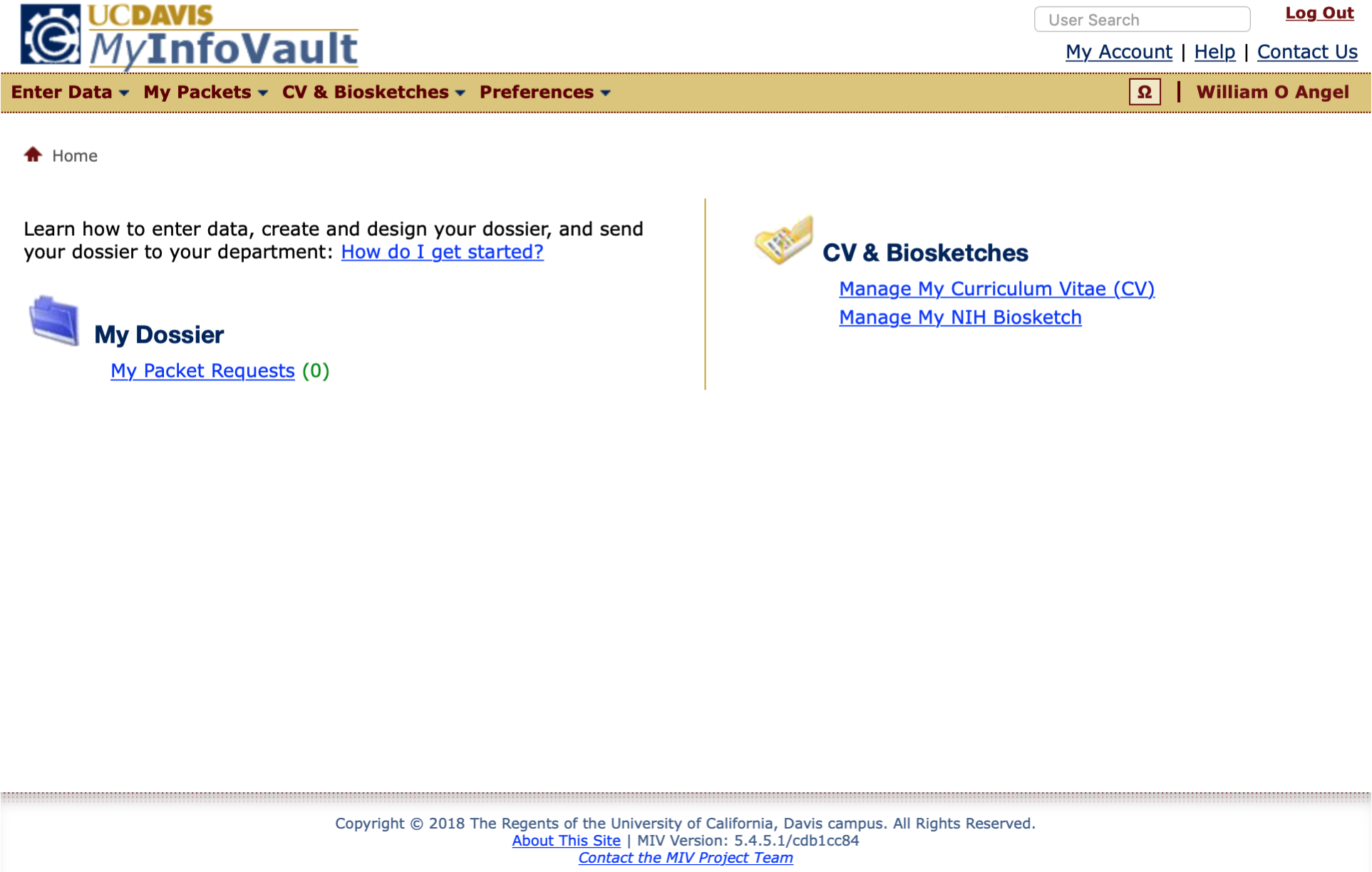
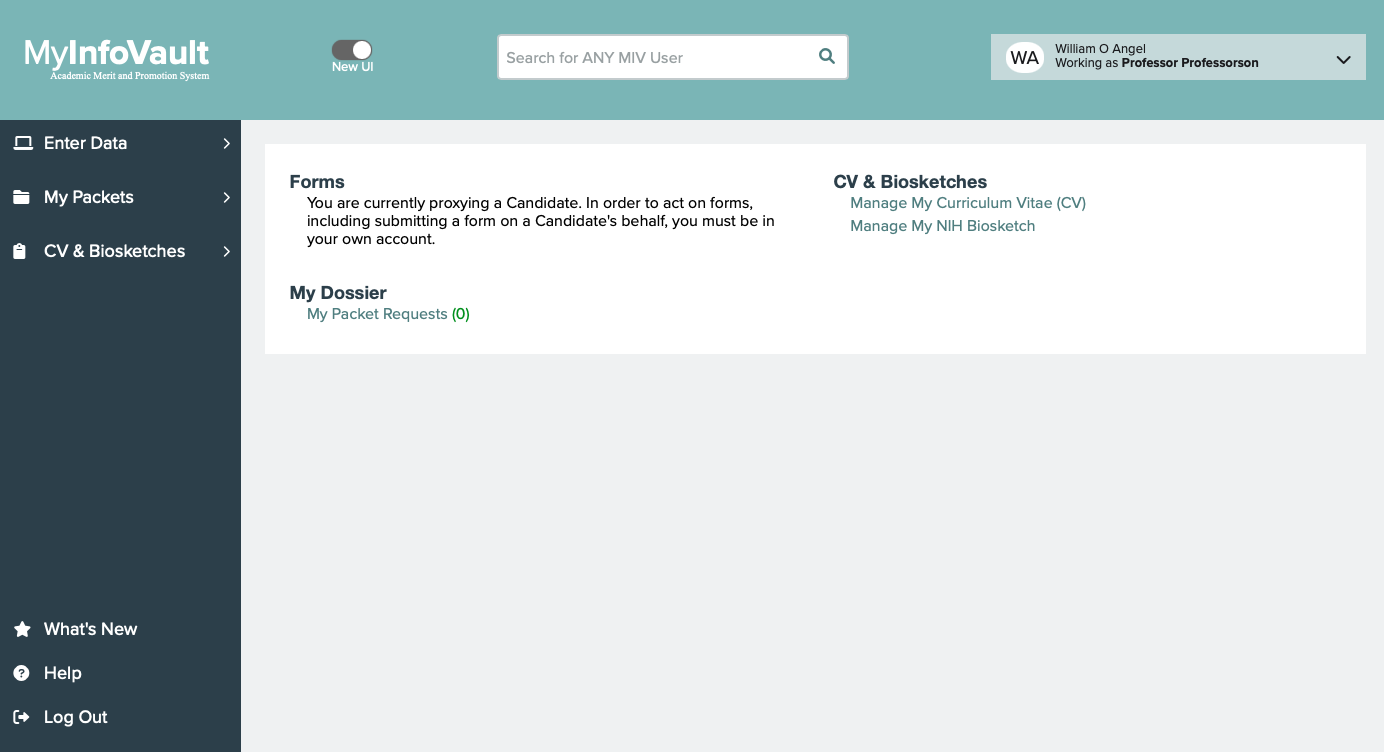
Either way, this is MIV's home screen. Most of your work will be done in "Enter Data", which you can see in the top-left under the MylnfoVault logo, but some other functions will be handled right from the home screen. Most notable among those will be your approval and signature of MIV actions, which we'll get to in a later section of this guide.
Now, let's begin. Do note that if you are promoting, there'll be some other tasks for you. They'll be detailed in a special email you receive, and mainly concern preparations for your extramural letters.
Entering Data
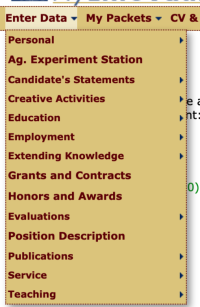
To enter data, our first stop will be, predictably, "Enter Data". When you hover over the button, you get a drop-down menu, which you can see on the right. As you hover your mouse over each category, more fields spring out. At this stage your first question, which I think everyone is on the same page with, may be "how much of this do I have to deal with". Mercifully, we can report: not all of it. The majority, but only a slight majority. MIV has to serve the whole campus, which means that several of the categories are not applicable to our purposes.
The general idea behind MIV is that all your information need only be entered into the system once. From that point, staff are able to build dossiers tailored to the review period for your specific action, without any need on your part to re-enter information. For example, committee service or journal publications you enter for a merit to Professor 4 don't need to be re-entered when you merit to Professor 6; the review period for a merit to Prof 6 goes back to your initial promotion to Professor because it is a barrier step, but info you've already entered remains valid.
With this in mind, we'd encourage you to update MIV on a rolling basis, rather than doing one big update every two, three, or four years. Setting aside an hour every two weeks seems a bit mindless, but it's a lot nicer than needing to update your entire file at once, with a deadline looming.
Lastly, do have a glance at the checklist for your specific action. They govern all the material that the department will be submitting on your behalf, and can be an additional source of "self service" help. You can find them online here.
Your Candidate Statement
Put simply, the Candidate Statement is a document in which you are given a maximum of six pages to tell the "story" of your research, service, and teaching during the review period in your own words. It's referenced by the Chair, Dean's Office, Academic Affairs, and committees at the College and University level (where applicable) when they review your dossier, and it tends to be (for better or for worse) the focal point of review by your peers at the voting and committee stages. It is optional, but it is atypical to submit a dossier which does not include one.
With that in mind, it's something that everyone involved (staff, the Chair, the Dean's Office) is happy to discuss with you. Your existing Candidate Statements, if any, will be in MIV from previous years, but you're also able to review those of your peers.
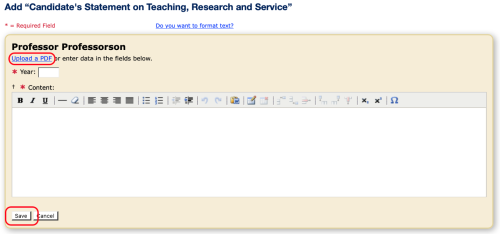
One general suggestion over all others: when you and Noelle are working together to prepare your packet, you'll be given a chance to review your complete MIV dossier. Make sure that everything in your Candidate Statement is supported by what's in the dossier. If supporting information is not in the dossier, either add it if it's within the review period, or remove it from the Candidate Statement if it's from outside the review period. We want to avoid a Statement for, say, a 7/1/23-6/30/25 Merit which references work done in 2021.
Otherwise, the Statement is really where you get to set the tone, so we'll leave it to your expertise. If you have any questions as you write it, please do feel welcome to get in touch with staff! Academic Affairs also maintains a guide with more information on the other optional statement types.
Extending Knowledge
Alright, so you've done the Statements. As we go down that Enter Data list, there's some items you don't have to worry about. Creative Activities, Education, and Employment can generally be left alone, for our purposes. Extending Knowledge is our next stop. We get a few choices here:

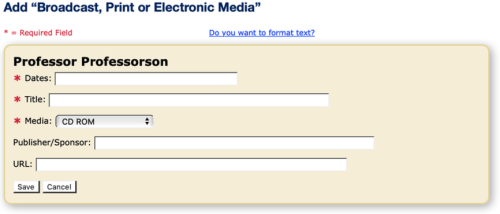
You may not have any pre-existing info in Broadcast, Print, or Electronic Media, and you may not need to put anything in it. However, it's a great place to list ways in which your work has been disseminated to a mass audience. For example, if you have done a radio interview, appeared on a podcast, or if a magazine article has been written about your work, this is the place to include that information. Entry is pretty straight-forward; it would be nice if we were able to upload PDFs here, but the URL field covers most bases these days.
Workshops, Conferences, Presentations, and Short Courses
One type of information that you'll almost certainly want to include, however, are the talks you've given. Extending Knowledge features the Workshops, Conferences, Presentations, and Short Courses section, but you'll notice a few categories in which "the general notion of presentations" sort of fits; Creative Activities has one, and Publications ➡️ Presentations also sounds tempting. On the face of it, determining where to put your work may require a bit of thought.
Ultimately the priority is consistency with your own past practice in MIV; unless advised otherwise by your Chair or staff experts, it's okay to keep doing what you've been doing. For those coming to MIV with fresh eyes, here is a bit of per-discipline guidance to help you draw a distinction between the two categories:
Economics
Guidance for your MIV entries in this category centers upon the specificity of the presentation. Some examples:
Publications ➡️ Presentations
- Presentations of your specific research.
- Panel discussions aimed at an audience specific to your area of interest
- Plenary addresses.
- Invited talks.
Extending Knowledge ➡️ Workshops, Conferences, Presentations, and Short Courses
- Conference talks and presentations which are general, and not about your specific research – or, only about your specific research in a very general way.
- Panel discussions aimed at an audience more broad than your specific area of interest.
- Policy briefs.
- Press interviews which you don't feel to be a good fit for the Broadcast, Print, or Electronic Media section.
- Expert testimony.
History
Guidance for your MIV entries in this category centers upon the academic specificity of the presentation. Some examples:
Publications ➡️ Presentations
- Conference presentations of your research.
- Invited talks which are academic in nature.
Extending Knowledge ➡️ Workshops, Conferences, Presentations, and Short Courses
- Serving as an invited speaker in a public role.
- Conference participation in a role other than presenting a paper, e.g. serving as a chair, commentator, or round-table participant.
If you are not sure which category applies, your Chair is a great resource.
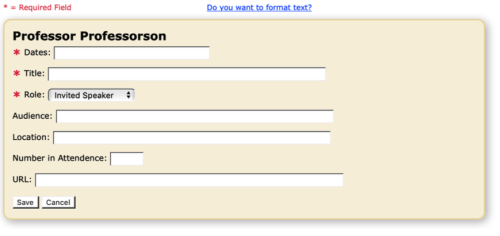
Anyhow, entering data is also pretty straightforward here. The drop-down menu has a few choices of role, but if you feel like the options don't adequately describe your role, feel free to choose "Other" and put your role in brackets in the title field.
The default sort is chronological; we'd strongly suggest you leave that in place rather than using the "Resequence" tool.
Grants and Contracts
Grants and Contracts allows you to list funding you have received. This isn't too bad, on the face of it; you can click "Enter Data", after which you're presented with pretty basic data entry. Fields like Funding Agency, Amount, Grant Number, and URL are not listed as "Required", but please add that information if at all possible. We would also suggest completing the Purpose/Goal and Contributions sections, the latter particularly if you are a Co-Pl.
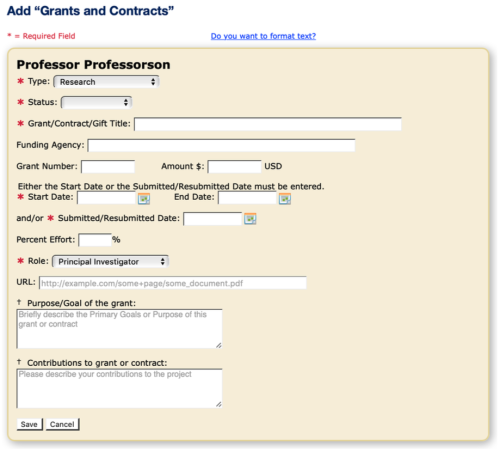
Grants and Contracts is a straight-forward section, but can pose a bit more work than most others. If you have existing material in MIV, you must go through and update the status of completed grants. You should also have a look through all the other fields to make sure changes that occurred in the Title, Amount, or Date fields are updated.
Here's three little points we'd like to add, in response to questions you might have:
- You may have a lot of Grants Not Awarded. That's okay. The benefit of the section is to show that, in cases where you may not have many active grants, you're still working and applying for things.
- Yes, funding from non-governmental agencies, corporations, and other parties is fine to list!
- MIV no longer allows you to enter annual funding amounts; it strongly prefers you enter totals. In some cases, that's not feasible. If that applies to you, you can enter the annual amount in Amount, then enter "[Annual Amount Given]" after the grant title.
You may also have some grants that begin right after your review period. That's just fine, and we'll include them. The Dean's Office is sensible in that regard, and accepts that work towards that funding occurred during the review period.
Honors and Awards
Here's another simple category. When you open up the Honors and Awards section, you're simply presented with a list of all your honors and awards in chronological order. When you click "Add a Record", it brings up a pretty straightforward data entry pane where only a year, name of the awarding organization, and a description of the award is required.
All sorts of things are valid entries for this section. Visiting lectureships, awards from professional organizations, honorary degrees – if it's an unusual recognition of your professional accomplishments, it can be included in this section. As with MylnfoVault's other sections, however, don't delete old items; even if they are not useful for your particular review period this time around, there'll still be times where we need to build a dossier that includes them.
Evaluations
More easy items for you! The long and the short of it is: don't worry about evaluations. Staff will be adding them, and inserting links to your evaluations. You'll have two tasks in this section:
- While entering data: Please make sure that sabbaticals and leaves of any sort are accounted-for on this page so that you don't have unexplained gaps in your teaching history.
- When we have a draft-final version of your dossier: Take a look at the classes listed and make sure that everything's there, and that links go where they should and support the info in MIV. An extra set of eyes never hurts.
Only Fall/Winter/Spring podium course evaluations are included; the exception to this is if you have an arrangement with the department to teach during summer in lieu of academic year teaching.
Publications
Predictably, the Publications section is where you reflect everything you've published.
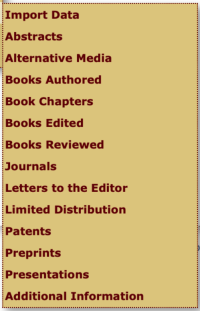
Now, bad news first. Before we get into it, here's a rule of thumb for the Publication section: If you are entering data and see a Contributions to Jointly Authored Works (CJAW) box, fill it out unless you are a sole author of the work in question. The Dean's Office also frowns upon copy-pasting CJAW statements, so please write them individually for each entry you do.
The good news is that these statements need only be a sentence or two long, and while the Dean's Office doesn't want you copy-pasting them, they're aware that there's only so many ways you can present a similar situation. So if you write CJAWs for 20 publications and they're all some variation on "The work reported was carried by the candidate at UC Davis. The paper was written by the candidate", that's fine as long as you're writing them individually for each one. You cannot be faulted for accurately representing reality.
With that said, the CJAW box is also the place where you would, for example, describe who contributed which parts of a paper that resulted from a collaboration.
This is a big driver of my earlier suggestion that you update MIV every couple weeks, or every time you publish a paper (or whatever other schedule works for you). Entering CJAW statement for a single paper is a mild annoyance that takes a minute or two. Entering 40 papers, each with its own CJAW, because you haven't updated MIV in years... is a big ol' pain. Now, with journals in mind, click on Publications -> Journals in the Enter Data drop-down, and let's talk about those.
Journals
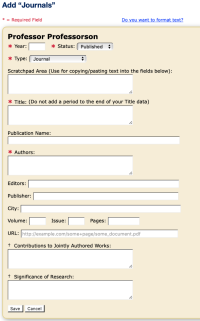
The Journals section is a great place to begin. You will almost certainly have some information already entered, so you can get a feel for the sort of information that's there. With that said, you can click "Add a New Record" and we'll get going.
The basics are pretty straight-forward. You've got all the usual fields. One minor observation is that you can omit punctuation at the end of the title; MIV will add that.
When it comes to listing authors, you can format them according to the following "hierarchy of decisions":
- If you have data already in MIV, we recommend keeping internal consistency with what you've already done.
- If you're pasting things in, stick to one style.
In the URL field, a public link is required. It can be either a journal link or a DOl link, however. That is, here are two valid URLs for the same paper:
http://dx.doi.org/10.1007/s10797-022-09760-y
https://link.springer.com/article/10.1007/s10797-022-09760-y
If there is no public link (perhaps your paper is pre-press, for example), please share a PDF version of your paper with Noelle (along with documentation of acceptance, if available) and she will be able to give you an accessible link for this list.
Presentations
As you may have seen above, there are two sections with similar aims when it comes to reflecting presentations you have given. There is the Extending Knowledge ➡️ Workshops, Conferences, Presentations, and Short Courses section, but Publications ➡️ Presentations also exists to cover ground which may seem substantially similar.
When discussing "what goes where", the priority is consistency with your own past practice in MIV; unless advised otherwise by your Chair or staff experts, it's okay to keep doing what you've been doing. For those coming to MIV with fresh eyes, here is a bit of per-discipline guidance to help you draw a distinction between the two categories:
Economics
Guidance for your MIV entries in this category centers upon the specificity of the presentation. Some examples:
Publications ➡️ Presentations
- Presentations of your specific research.
- Panel discussions aimed at an audience specific to your area of interest
- Plenary addresses.
- Invited talks.
Extending Knowledge ➡️ Workshops, Conferences, Presentations, and Short Courses
- Conference talks and presentations which are general, and not about your specific research – or, only about your specific research in a very general way.
- Panel discussions aimed at an audience more broad than your specific area of interest.
- Policy briefs.
- Press interviews which you don't feel to be a good fit for the Broadcast, Print, or Electronic Media section.
- Expert testimony.
History
Guidance for your MIV entries in this category centers upon the academic specificity of the presentation. Some examples:
Publications ➡️ Presentations
- Conference presentations of your research.
- Invited talks which are academic in nature.
Extending Knowledge ➡️ Workshops, Conferences, Presentations, and Short Courses
- Serving as an invited speaker in a public role.
- Conference participation in a role other than presenting a paper, e.g. serving as a chair, commentator, or round-table participant.
If you are not sure which category applies, your Chair is a great resource.
Other Publications
As you saw, there are many other categories in which you can place publications. Books or book chapters written and books edited may well be part of your body of work, and are given specific categories in MIV. Do use them as you see fit. For brevity's sake we'll spare you a sub-section, but data entry for each category works similarly to Journals – you simply open the list and click "Add a New Record".
We have just a couple of cautions:
- Links are necessary. If a publication is not available online, as with in-press journal articles, please either provide a shared Box link or share a PDF version of your work with Noelle, who can create an accessible link.
- Please ensure that the version of the paper/book/etc. you link to has the same title as the title you enter in MylnfoVault. Titles which vary will get a revision request from the Dean's office.
- Please let Noelle know if a publication should be marked "@"/"Refereed".
That's more or less it, as far as publications are concerned. There's a bit more that'll go in, but (from your perspective), it's no problem.
What we'll be doing after you finish up is ensuring that the publications flagged as "in review period" make sense, and that we do not double-count any from your last review. We'll also be making sure your last merit or promotion is reflected in the pub list (say you got a merit after publication #180 – we'll simply put a line after #180 that says "Since Merit to Professor, Step 6".) Lastly, we'll ask if there are any publications you wish to have flagged as "Most Significant" or "Major Mentoring Role". All these flags are done through the annotation controls, which you do have access to — but on general principle, they're fussy enough that it's generally quicker for staff to just do it for you. If you'd like us to show you how to alter them yourself, though, the staff would be glad to sit down and go over it.
Service
The Service section, as the title implies, allows you to reflect service you have rendered in any form, on campus or off. As you'll see, there are a few options; we'Il address them in three parts.

Administrative Activities
This section is rarely used. However, rarely isn't never; if you have performed any service which required a significant portion of your time in administration, it likely counts as an Admin Activity. As an example, several members of our current faculty have served as the department's Chairperson, which absolutely counts. If you have any questions about whether or not some duty you have performed should be included in this section, do feel free to get in touch.
Committees
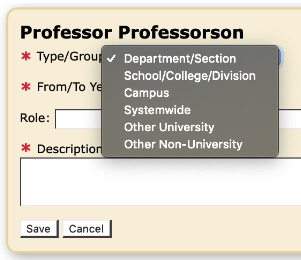
The bulk of your entries will likely be in Committees. This section allows you to enter a type, which you can see to the right, and then a few details. It's not too onerous. The Dean's Office now prefers contiguous entries, e.g. "2019-2023: Member, L&S Computing Support Committee", rather than single-year entries.
Pretty straight-forward, though! Start date, end date, role, and committee name.
Editorial Boards
The Editorial/EAB/etc. service section is also not too bad. If you click on "Add Data", you'll see it's just a year range and a description. As with Committee service, however, there are a couple of recent changes to be aware of. What had been okay for years is something like this:
2008-present: Advisory Board Member, Reviews in American History
There are three changes:
- As with Committees, please no longer use "-present" or "-current".
- They now recommend including a count of publications handled per year, if that is an applicable metric.
So, that previous example now looks a little something... like this:
2008-2025: Advisory Board Member, Reviews in American History
In this example, our hypothetical professor's review period ends in 2025, so that is fine. If you are concerned about the way this looks, please feel free to add "[ongoing]" between the journal title in the description field.
Additional Information
This section was not used very much in years past. It has become helpful, however, as Dean's Office criteria for what is included in other categories grows narrower. For example, reviewer service or membership in professional organizations used to be thrown in Committee Service - but no longer.
Recommendation: In Additional Information, we would suggest you add a section for "Reviewer Service" at the least if it is not already included in the Editorial Boards section; if it is, we would recommend simply maintaining internal consistency with what you already have. As with the Editorial section, the campus now wants a count of your reviewer activity if possible. An example of the complete entry would look like:
Reviewer Service [in a custom heading] During the review period, I reviewed manuscripts for the following publications: Historian (9 papers reviewed); Journal of American History (4); National Tax Journal (7); AER-Insights (3)
Teaching
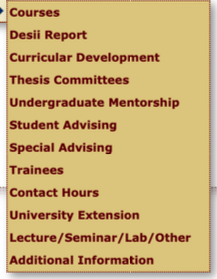
The teaching section can be the source of some bother. It's not necessarily the content you have to put in that's frustrating. Rather, the terminology used is not quite clear in some spots, perhaps driven by the fact that MylnfoVault needs to serve departments all over campus. As with the other chunks of MylnfoVault, however, it's nothing too unpleasant when dealt-with in small bites.
When you hover over the Teaching section, you'll see the following list. As this is a broad section, we'll approach it in subheadings – however, you'll likely be able to ignore several of them.
Courses: Unused. Don't worry about it.
DESII Report: This isn't one you have to worry about, but there will be information here. The DESIl ("Data Editing System for Instructional Information") report is a UC system that gives credit to all instructors (TAs included), and it produces a report that simply reflects credit given for instructional service. It's something that staff will pull right from the Budget and Institutional Analysis DESII system and add to your MIV file. So, you'll be able to review it, but there's nothing you need to do. (It effectively supercedes "Courses")
Curricular Development: This is a section you may wish to use. It gives you a year field, and a freeform text entry box. As the title suggests, it's the place to list any curricular development you've participated in. That definition is essentially up to you; if you participated in, for example, the implementation of a new undergraduate course, that absolutely fits. And, if you've been employing some new technology or teaching practice in your own lectures, that counts too.
Thesis Committees: You'll likely have some work to do here. If you are on a student's committee, they should be reflected in this category. The data entry is pretty straight-forward; as with your entries in Service, please use either the end of your review period or a project end date for your committee service as the end date, rather than "-present". Please indicate whether you were the Chair, Co-Chair, or a Member of each committee.
Undergraduate Mentorship: In this section, you can reflect undergrad students for whom you've filled a significant mentorship role. 99s/199s qualify, as does mentorship toward those students' grants, awards, etc. It's a relatively uncommonly-used section, but with that said, it certainly couldn't hurt. I'll add that if you only plan to list 99s/199s, they do show up in the DESIl report too.
Student Advising: Both Economics and History are moving away from using this section; you may have data within, but there is no need to update it for your current and future advancement actions.
Special Advising: This is where things get slightly fussy. Special advising covers a lot of ground. To put it shortly, you can reflect QE committee service in this section (simply academic year by academic year, with a list for that year in the freeform text box). Some faculty choose to put them in the next section, Trainees. Either is acceptable.
- Starting from a blank, it is generally preferable to leave only your direct advisees in Trainees.
- If you already have information in MIV, I'd suggest keeping consistency with whatever you were doing.
Trainees: This section allows you to reflect anyone you'd consider a trainee. As suggested above, there's a bit of interpretation for you to do. If you did not reflect undergrad researchers in the Undergrad Mentorship section, they can go here, as can QEs if you didn't put them in Special Advising. If you do include QEs here, make sure to include your role and the QE designation in "Trainee Type" under "Add a New Record". It's a bit hard to offer concrete advice since internal consistency is sort of the "high order bit" when it comes to these sections.
Contact Hours: Don't worry about it; it's not needed.
University Extension: If you have any involvement with the UNEX, it can be entered here. If you do, and you have any questions about the content of this section, do let staff know and we can have a look together.
Lecture/Seminar/Lab/Other: This section is only used very rarely by Blue Cluster faculty, so you can likely ignore it. However, if you have given a impromptu teaching session which doesn't fit in another category and which you believe should qualify, it can be included in this section.
Additional Information: Like Service: Additional Information, Teaching: Additional Information lets you input your own headings, so the section is what you make of it. You can ignore it, however, as it's very rarely used. Two exceptions come to mind:
- If any of your students have received special grants for work done under your mentorship, that would be appropriate to highlight here.
- If you'd like to highlight any presentations given by students under your mentorship, this would also be a fine place to do so.
...and with that, we're done with Teaching! For the time being, you're also done with MyInfoVault. However, that isn't the end of the process.
What's Next?
The formal procedure is spelled out in the APM, linked earlier, so we'd encourage you to have a look. However, here's an informal overview of what you can expect in the merit/promotion/advancement process.
- You let staff know that you're done with your MIV data entry. Great! Noelle will take the information you've entered and construct a packet for your advancement, including your evaluations and DESIl report, based on the review period you'll have. You'll likely have a bit of back-and-forth with revision requests.
- At this point, there is a difference in departmental practice. For Economics faculty, your packet will be reviewed by an ad-hoc committee for promotions, appraisals, and merits. For History faculty, an ad-hoc committee will review your packet only if it is a promotion, with a merit committee serving in that capacity for other actions.
- The vote. Once your packet is complete, it goes up for a vote amongst your peers. Based on your advancement type, it may be accompanied by an ad-hoc letter, or adhoc and extramural letters. "Your peers" means that some faculty members may not be able to vote on some actions, based on rank; this is defined in your department's voting procedures document.
- The vote result. Along with your dossier, the vote's result is shared with the Chair's Office. They'll be writing the department letter, which goes to Noelle so that she can...
- Assemble the action. At this point, the formal action is built in MylnfoVault. It includes the Action Form (which formally requests your new position), the department letter, your dossier, and extramural letters if applicable.
- Packet Request. Although you indicated that your packet was okay before the vote, that's not considered a formal submission. As part of the assembly, Noelle will have MIV formally request the packet from you. In practice, she takes care of the Packet Request for you, but doing so does generate some automated emails on this point (which you can generally disregard).
Now, the action's ready! There's one last step...
Candidate Disclosure Certificate
Noelle will have MIV request a Candidate Disclosure Certificate (CDC, for the purposes of this booklet) from you. This is the final step, and the point at which you formally approve your packet; once you've signed and let us know, the action can be submitted. There are a few things to be aware of, though.
"Disclosure"
The essential point of the CDC is to certify that you've been able to review and approve every part of the action. Using the "View Complete Dossier" button, you can do exactly that. You'll be able to see the department letter, action form, and (redacted) extramural letters.
Action Form
As mentioned on the facing page, the Action Form is a formal request for your new position.
About the Letters...
There's a couple things to keep in mind with the department and extramural letters. For the department letter alone, you can request changes to address factual inaccuracies. For the extramural letters and the department letter, you can prepare a formal response (a rebuttal and a rejoinder, respectively). Staff or your Chair would be happy to discuss that process with you directly. However, you are guaranteed 10 calendar days to do so, regardless of any deadlines.
Long story short, the final word in your advancement belongs to you.
Approvals and Revisions
Once you send staff a Rebuttal or Rejoinder you'd like to include, and sign the Candidate Disclosure Certificate, you're all set. If you have a dual appointment, there will be another Disclosure Certificate request from your secondary department, but formally it will not differ from the one Blue Cluster requests (and neither will your APM-guaranteed rights differ).
When you've signed off on the file, you can let Noelle know, and she will submit the file to the Dean's Office. It's now out of our hands.
Revisions
We will likely have a few revision requests come back from the Dean's Office. Generally they are minor requests, where a journal pub's title might differ from the linked version, or a stray service item outside of your review period. For things like this, Noelle can just take care of them and give you another Disclosure Certificate for your final approval. Revisions can take a bit of time to arrive.
The Waiting Game
Once all this has been addressed, you'll quite reasonably be wondering when your advancement decision will be returned. Staff are happy to help look into it, although generally-speaking can only see a vague level. With that said, Noelle and Will are able to make inquiries with the Dean's Office if circumstances suggest that doing so may be necessary.